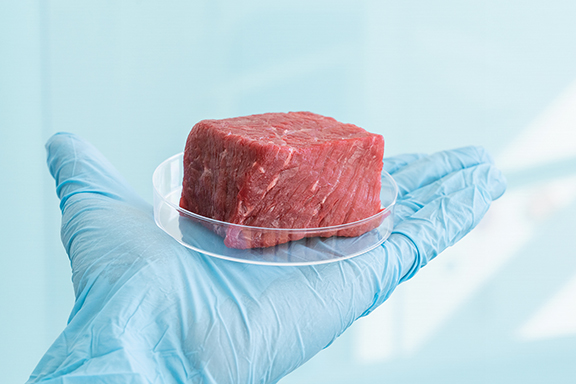Evaluating Pros and Cons of Alternates
By Mohammad Abdullah
July/Aug 2024

A Feb. 5 Washington Post headline proclaimed, “Your plant-based meat could soon have animal fat because the taste experience is not at par with real meat.” The story looked at this relatively new type of meat created from plant ingredients. This procedure is considered more humane and environmentally sustainable than livestock farming and slaughtering. However, the number of U.S. consumers eating it hasn’t changed over the past 20 years and has remained relatively stable as less than 10 percent.
The University of Edinburgh (Aug. 25, 2023) research suggests that despite sustained growth for several years, plant-based meat products sales are now stagnating. People wonder if such meat alternatives will ever replace the real thing.
Real Meat, Plant-based Meat Alternatives and Climate Change
Food analysts find no signs of plant-based meat alternatives entirely replacing conventional meat because consumers are making choices based on cost and flavor. Presently, the most-commonly used fat in plant-based meats is coconut oil, which doesn’t give the flavor that animal fat does. Some companies now cultivate blocks of pork belly fat in the laboratory and even add such meat byproducts as fat trimmings, collagen and broth components to plant-based bacon, meatballs and sausages.
Scientists, well-aware of the importance of sustainability, want to see some meat alternatives, because animal-based agriculture is a big part of the advanced stages of the world’s largest-ever environmental catastrophe. According to the Intergovernmental Panel on Climate Change and FAO, a fully developed cow can emit up to 500 liters of methane each day. In addition, raising livestock for human consumption generates nearly 15% of total global greenhouse gas emissions — greater than all transport emissions combined. And cows produce more methane gas than all other ruminants combined. (“Global Warming and Dairy Cattle,” www.ncbi.nlm.nih.gov>pmc).
After agriculture, fossil fuels are the largest source of methane emissions. More than 150 nations have joined the Global Methane Pledge and vowed to cut releases of greenhouse gas by 30% by the end of this decade from 2020 levels (Bloomberg News, March 25).
It may seem like we’re undergoing a massive transformation. However, “first-generation” meat alternatives like tofu — first recorded in China about 2,000 years ago — and tempeh — first documented in the 1600s in a Central Java village, are well known. These protein-rich foods bear little resemblance to meat. “Second-generation” plant-based meats, however, like Beyond Meat and the Impossible Burger, are designed to look, cook and taste exactly like meat.
Michigan State University’s Department of Biosystems and Agricultural Engineering explains the plant-based meat lifecycle: Extract proteins from raw materials, (https://seas.umich.edu/) and use heat through an extrusion-process to structure/texturize the proteins. To give consumers that taste and color of blood, Impossible Burgers use a protein called heme, drawn from the root nodules of soybeans. The soybean DNA is extracted and inserted into a genetically engineered yeast, which is fermented to produce heme, and then mixed in with the other ingredients. When it is cooked, an Impossible Burger releases its heme. Beyond Meat, on the other hand, uses beet juice for that characteristic red color associated with meat. The two burgers are almost identical when it comes to nutrition.
Corn and soy are often key ingredients in plant-based meat alternative products, and more than 92% of U.S. corn and soy is genetically modified (https://ers.usda.gov>recent-trends).
In case you haven’t noticed, as of Jan. 1, 2022, “GMO” labels on grocery store food and beverage products require the phrase “bioengineered” or “derived from bioengineering.” But new rules exempt foods sold by restaurants, food trucks, delicatessens or served by airlines (“Read the Labels Carefully Before You Eat,” https://issuu.com/isnacreative, May/June 2023).
A 2018 University of Michigan study by Martin Heller (core staff, research specialist, Center for Sustainable Systems) compared the Beyond Burger to a quarter pound of beef and found that “Beyond Burger generates 90% less greenhouse gas emissions, requires 46% less energy, and has 99% less impact on water scarcity and 93% less impact on land use.” Similarly, the Impossible Burger’s carbon footprint is 89 % smaller than a beef burger and uses 87% less water and 96% less land (https://css.umich.edu).
Unresolved Issues
According to a report in the foodnavigator-usa.com (Feb. 17, 2023), 63% of U.S. consumers began eating plant-based products because they are perceived as healthier, while 40% started eating plant-based products because they felt doing so is better for the planet.
But the existing meat substitutes aren’t as affordable as real meat, not similar enough in taste and haven’t been proven to be healthier. So, many consumers cannot justify spending money on these products to help the planet (“The Big Bet on Meat Alternatives Fails,” Newsweek, June 11, 2023).
Interestingly, while the Stockholm Environment Institute has reported producing animal-based food accounts for as much as 20% of total greenhouse gas emissions, a key driver of biodiversity loss, the world’s appetite for real meat has more than doubled since 1990. Reaching 339+ million metric tons in 2021, the U.N. Food and Agriculture Organization (FAO) predicts that it will rise to 374 million metric tons by 2030. (“Alt-meat fever has cooled,” Washington Post, Nov. 12, 2022).
The taste might not be the same as traditional meat, and it cannot be synthesized naturally by the body. A comparative assessment study of both meat products’ nutrition profile found that “When compared to meat burgers, plant-based burgers had an unpleasant taste, less juicy, dry, and grainy. In fact, texture attributes, such as fibrous structure, tenderness, and juiciness of meat protein, are very difficult to recreate in plant-based analogues according to this study” (https://www.ncbi.nlm.nih.gov>pmc).
And the May 12, 2023, Washington Post opinion piece “Where is the Beef?” stated that the taste, texture and smell of fake meat are unappetizing; too expensive; the ingredient lists are too long; and it isn’t well suited to American culture. Companies should stop playing imitation games. Properly prepared vegetables are likely to taste better than vegetables pretending to be ground beef. In the meantime, invest in ways to make real meat production more efficient and ethical, as well as less environmentally destructive.
While arguments can be made on both sides, plant-based meat products offer some nutritional benefits such as low saturated fats and cholesterol, in which animal proteins are known to be high. They also offer a more sustainable approach with reduced land and water, lower emissions and can help address the problem of protein for individuals with limited access to animal-based proteins. A 2013 analysis from the University of Minnesota found that if existing cropland was used to feed people directly, 4 billion more people would be fed (Science Daily).
Although beef alternatives might be better for the environment, they might not necessarily be better for your health. David Katz (founding director, Yale University’s Prevention Research Center) says that “plant-based meat products like Beyond Meat are not nutritional alternatives to real plant foods, like beans or lentils, which provide enough nutritional value on their own. The problem is that the marketing surrounding these meat alternatives has been pitched exactly that way.” And according to a July 3, 2019, Harvard Gazette article, the health effects of these products need to be monitored, because, “plant-based” does not necessarily mean “healthier” (https://www.hsph.harvard,edu>news).
The promise of “alt protein” was to create healthier alternatives so indistinguishably delicious from the real thing that they would eventually overtake the entire industry. Although this goal is worthy, it has yet to become a reality (Fast Company, May 22, 2023).
One driving force behind plant-based meat is the increasing awareness of traditional animal agriculture’s environmental impact. The growing business of food technology is also revolutionizing the way we eat. Some industry experts consider cellular agriculture the wave of the future, and a growing number of companies are focused on developing lab-grown meat.
A Kansas City Star headline in November 2023 proclaimed “Meat made from cells (lab-grown), not slaughtered livestock, is here. But will it ever replace traditional meat?” My response, “Lab-grown meat is closer every day,” published in their print and online editions in March 2024, was that it depends, among other things, largely on their prices and consumers liking it as much as they like traditional meat. Even then, a segment of society might reject it or be highly processed or potentially have an even larger carbon footprint.
Marketing leads us to believe that plant-based burgers consist solely of plant ingredients. However, these heavily processed foods contain preservatives, additives, fillers, texturizers and chemicals linked to cancer, and are high in sodium and low in nutritional quality. On May 12, 2022, The Wall Street Journal and New York Post ran full page ads against these products and asked readers to see what they are really eating (www.cleanfoodfacts.com/ingredient-guide/).
According to David Lovell (environmental scientist, Stanford) both types of meat are unlikely to offset livestock agriculture’s climate and land use impacts anytime soon. In the meantime, policymakers would do well to focus on ways to dramatically reduce emissions of animal-based systems (www.news.stanford.edu).
How You Can Help
When will policymakers come up with ways and means to dramatically reduce the emissions of animal-based systems? People can help by reducing food waste and meat consumption, among other things. If everyone skips a hamburger, it saves us 660 gallons of water, 64.5 square feet of land, 13 pounds of feed and 5 kilograms of CO2 according to Vegetarians vs Vegan vs Flexitarian Diet – Everything you need to know (www.naturesfynd.com/blog).
Instead of completely eradicating meat from our diet, we should leave behind a carbon footprint, a measure of our impact on the environment. Reducing meat consumption and mitigating food waste will help considerably slow the current unsustainable cycle of livestock supply and demand, especially in the face of climate change.
Mohammad Abdullah, DVM, MS (Agri. Tech.), MPH, who retired after serving 29 years with the U.S. Department of Agriculture’s Food Safety and Inspection Service — the agency that regulates the meat industry — is the author of “A Closer Look at Halal Meat from Farm to Fork” (2016).
Tell us what you thought by joining our Facebook community. You can also send comments and story pitches to horizons@isna.net. Islamic Horizons does not publish unsolicited material.
